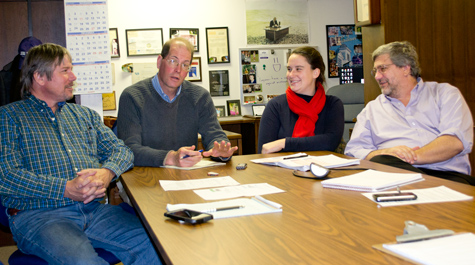How to monitor oil spills under the ice? Just go with the floe
The Deepwater Horizon disaster of 2010 went on for 87 days. The breached underwater well pumped out an estimated 210 million gallons of oil into the Gulf of Mexico. Monitoring technology allowed responders to direct resources to intercept the spreading oil plume and prevent the catastrophe from becoming even worse.
Monitoring techniques and technologies that are reliable in the warm open waters of the gulf aren’t necessarily much use in the Arctic, especially if there is oil spreading underneath several feet of sea ice. Sam McClintock says it’s a scenario that’s bound to happen.
“It’s just a matter of when the next oil leak is going to occur up there,” said McClintock, CEO of Midstream Technology. “Hopefully it won’t be catastrophic.”
Midstream is a Williamsburg-based tech-development firm. Midstream officials have been working in conjunction with Mark Hinders, professor of applied science at William & Mary, to develop technology to track oil spills under ice. The group is collaborating with Evigia Systems and URS Group to develop the under-ice monitoring technology, backed by two contracts with the U.S. Bureau of Safety and Environmental Enforcement (BSEE), part of the United States Department of Interior. Midstream is a subcontractor under URS group.
Hinders and McClintock have collaborated on other technology initiatives, notably Sonic Nets, a project to develop a benign acoustic “scarecrow” to shoo birds from areas such as airport runways and fields of ripening crops.
Their idea to track oil spills under the ice is essentially a technique to harness two kinds of technology in a sort of a relay system. The segment above the ice, Hinders explains will use satellite RFID devices. RFID, or radio-frequency identification, is a class of technology in wide use. RFID tags are common tracking devices in industry, agriculture—even libraries. Once you’ve installed or embedded a teeny RFID tag in something, you can use satellite or an internet connection to track it via radio waves.
“They do a beautiful job of tracking whatever you want wherever it is in the globe. The problem is that once you have identified an oil spill under the ice, radio waves don’t go through ice or water,” Hinders said. “So how do we get the information about the location of the oil spill from the underside of the ice to the top side of the ice?”
The collaborators’ idea is to deploy an underwater tag in the oil pool. The tag will be housed in a sturdy, slightly buoyant carrier somewhere between the size of a softball and a volleyball. The device will be deployed by a submersible, either manned or unmanned, Hinders said. The tag will have a specialized speaker, designed to project an acoustic signal up through the ice.
“We call it an underwater ID tag—UWID,” Hinders said. “The tag is deployed where the oil is underneath the ice. The ice floe moves along and takes the oil with it. That’s the really tricky part, because the ice floes all look the same from the top.”
He explained that the buoyancy of the tag would allow it to rise up and lodge into crevasses on the underside of the ice, literally going with the floe—and the oil underneath it.
Atop the floe is the second part of the system, an “ice dart” dropped into the ice. The ice dart contains technology to receive the acoustic signal from the tag and relay it via RFID to a satellite and, ultimately, to the people who are monitoring the spill and coordinating the response.
McClintock noted that the prospect of an Arctic oil spill is a matter of concern and even anxiety for the petroleum business as well as the governments of both the U.S. and Canada. As a result, North Slope oil production is among the most well monitored industries on earth.
“If even a tablespoon of oil hits the ground up there, there’s going to be someone there to clean it up,” McClintock said. “They do get spills occasionally, but they haven’t been catastrophic in nature, but now we’re talking about oil leases that are all through the Bering Sea. Plus there’s additional shipping activity due to the shrinking of Arctic ice, and some of those ships are carrying oil. Most people think that it’s just a matter of time until something catastrophic does happen. And it’s best to be ready for it.”
He said the oil companies have even formed a nonprofit called Alaska Clean Seas, an organization specifically formed to respond to oil spills. The William & Mary-Midstream group, which includes Elizabeth Skinner, a Ph.D. student in applied science, and Ted Hale ’82, Midstream’s chief technology officer, are planning a round of cold weather tests of UWID devices.
“By odd chance, we’re going to be testing this technology in New Hampshire at the Army’s Arctic Research Center at the same time that Alaska Clean Seas is up there testing how to get the oil out from underneath the ice,” McClintock said.
In addition to tracking the oil itself, another part of the project is to develop an RFID system to track all the equipment necessary to respond to a large oil spill. “Track it in the warehouse. Track it in the staging area. Track it on the trucks wherever it needs to go,” Hinders said. “So that the people responding to the disaster know what they have and where it is.”
The team will be testing their UWID devices in real Arctic conditions in a little more than a year.
“In February 2016, the three of us [Hale, McClintock and Skinner] and another guy will be on an ice floe, fending off polar bears,” Hale said.
“But most importantly,” Hinders added, “Professor Hinders will not be going. Having spent time in North Dakota in the winter, I have no desire to go to Alaska.”
















